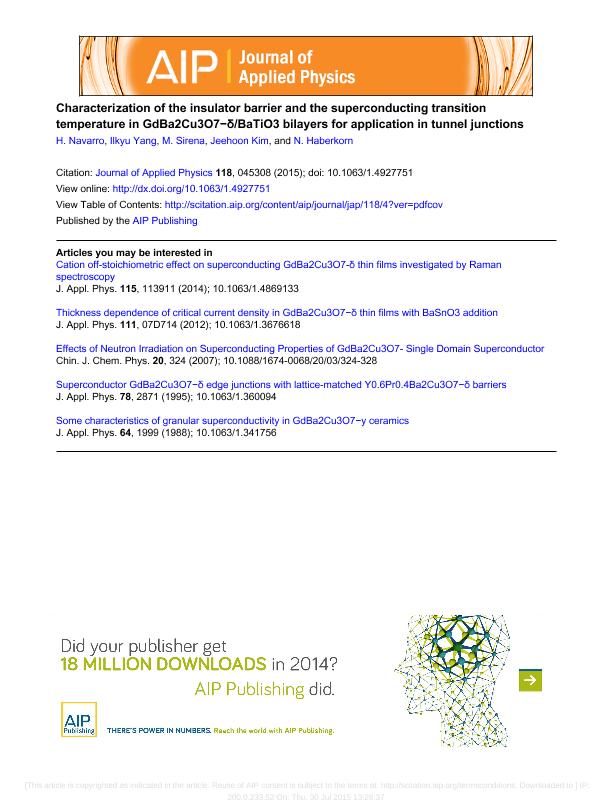Artículo
Characterization of the insulator barrier and the superconducting transition temperature in GdBa2Cu3O7-δ/BaTiO3 bilayers for application in tunnel junctions
Navarro Fernández, Henry Luciano ; Yang, Ilkyu; Sirena, Martin
; Yang, Ilkyu; Sirena, Martin ; Kim, Jeehoon; Haberkorn, Nestor Fabian
; Kim, Jeehoon; Haberkorn, Nestor Fabian
 ; Yang, Ilkyu; Sirena, Martin
; Yang, Ilkyu; Sirena, Martin ; Kim, Jeehoon; Haberkorn, Nestor Fabian
; Kim, Jeehoon; Haberkorn, Nestor Fabian
Fecha de publicación:
30/07/2015
Editorial:
American Institute of Physics
Revista:
Journal of Applied Physics
ISSN:
0021-8979
Idioma:
Inglés
Tipo de recurso:
Artículo publicado
Clasificación temática:
Resumen
The optimization of the superconducting properties in a bottom electrode and the quality of an insulator barrier are the first steps in the development of superconductor/insulator/superconductor tunnel junctions. Here, we study the quality of a BaTiO3 tunnel barrier deposited on a 16γnm thick GdBa2Cu3O7-δ thin film by using conductive atomic force microscopy. We find that the tunnel current is systematically reduced (for equal applied voltage) by increasing the BaTiO3 barrier thickness between 1.6 and 4γnm. The BaTiO3 layers present an energy barrier of 1.2γeV and an attenuation length of 0.35-0.5γnm (depending on the applied voltage). The GdBa2Cu3O7-δ electrode is totally covered by a BaTiO3 thickness above 3γnm. The presence of ferroelectricity was verified by piezoresponse force microscopy for a 4γnm thick BaTiO3 top layer. The superconducting transition temperature of the bilayers is systematically suppressed by increasing the BaTiO3 thickness. This fact can be associated with stress at the interface and a reduction of the orthorhombicity of the GdBa2Cu3O7-δ. The reduction in the orthorhombicity is expected by considering the interface mismatch and it can also be affected by reduced oxygen stoichiometry (poor oxygen diffusion across the BaTiO3 barrier).
Palabras clave:
Thin Films
,
Bilayers
,
Superconductor
,
Ferroelectricity
Archivos asociados
Licencia
Identificadores
Colecciones
Articulos(CCT - PATAGONIA NORTE)
Articulos de CTRO.CIENTIFICO TECNOL.CONICET - PATAGONIA NORTE
Articulos de CTRO.CIENTIFICO TECNOL.CONICET - PATAGONIA NORTE
Citación
Navarro Fernández, Henry Luciano; Yang, Ilkyu; Sirena, Martin; Kim, Jeehoon; Haberkorn, Nestor Fabian; Characterization of the insulator barrier and the superconducting transition temperature in GdBa2Cu3O7-δ/BaTiO3 bilayers for application in tunnel junctions; American Institute of Physics; Journal of Applied Physics; 118; 4; 30-7-2015; 45308-45314
Compartir
Altmétricas



